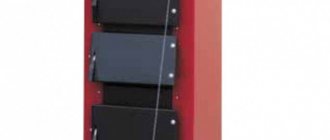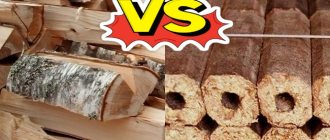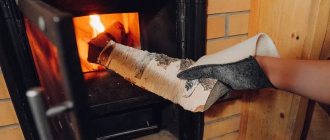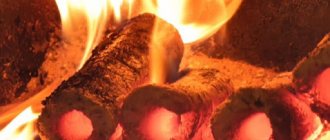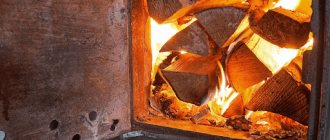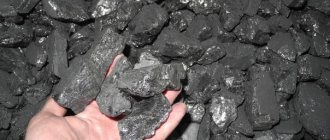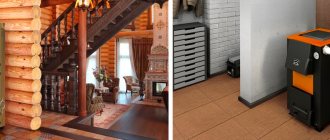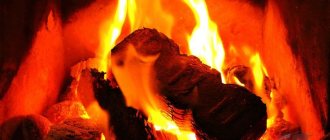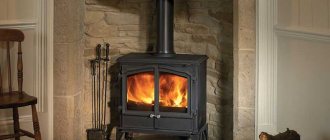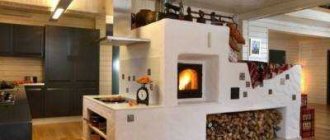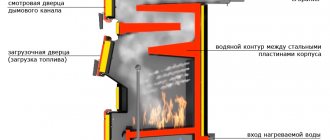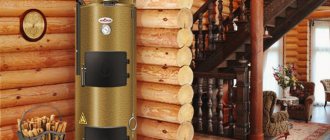What you need to know to calculate
Before calculating fuel for the entire season, you need to clarify a number of points, since firewood consumption depends on several factors. Here is a list of questions that require answers:
- How much heat is needed to heat a country house in your area of residence?
- What type of wood is planned to be burned?
- What is the moisture content of this wood? Is it freshly cut, semi-dry, or has it been around for a year or two?
- What is the efficiency (COP) of your heating unit? Indicated in the passport for a solid fuel boiler or stove.
You might say that rather than collecting all this data, it’s easier to use an online fuel consumption calculator. But not everything is so simple; the calculators presented on various sites are programs written by people. The calculation results must be checked to ensure their correctness. The best way is to calculate the amount of firewood and the cost of heating yourself, and then, to be sure, you can run the numbers on any online calculator.
Thermal energy consumption for heating a private home is determined by calculations performed by specialists or by an aggregated calculation method. For most homeowners, the second option is more acceptable, since you have to pay for the first. Its essence is this: on the coldest days, 10 kW/h of heat is allocated to heat 100 m² of building area located in a temperate climate zone. Taking into account the temperature change during the heating period, the average consumption during the season will be 5 kW/h.
Different types of wood release different amounts of thermal energy when burned, which is why it is important to know this in advance. The table below shows the calorific value of firewood of different types, referred to a measure of volume - 1 m³:
As can be seen from the table, the moisture content of wood fuel also affects the calorific value. The drier the wood, the more energy can be obtained per unit volume. This is understandable: when raw wood burns, part of the heat is spent on evaporating moisture and is not used to heat the house.
The efficiency indicator (EI) makes it clear what part of the thermal energy from burning fuel the boiler is able to direct into the heating system, throwing the rest into the chimney. This value is specified in the technical data sheet of each heat generator. For those who have not yet purchased a wood-burning heat source, here are the efficiency indicators for various heaters:
- when burning in a classic solid fuel boiler, 70 to 75% of the heat is used;
- the same, in a pyrolysis boiler - 80%;
- Russian brick or bell-type oven – 65%;
- steel or cast iron stove – no more than 55%.
Note. The efficiency value indicated for a pyrolysis heat generator corresponds to reality when working on dry wood (humidity 20%). If you “feed” this boiler with raw firewood, then its efficiency will not exceed 60...70%.
Solid fuel boilers of various types. How to heat them correctly?
*
While the theoretical part is a bit clear, in practice the situation looks different. There is no general template for how to heat a solid fuel boiler with wood. Each solid fuel heating device has its own specifics and nuances. This concerns not only fundamental differences in the operation of units, but also the smoother choice of fuel. We mainly deal with three types of wood-fired boiler equipment. These are the following types of solid fuel boilers:
- pyrolysis type units;
- long-burning wood-burning boilers;
- classic heating devices.
In addition to the difference in operating principle, many heating devices differ in the way they load fuel. There are models with manual loading of firewood, as well as products in which this process is semi-automated.
Let's consider the situation with firewood for each type of heating device.
Pyrolysis boilers. What is the situation with firewood for boilers of this type?
Ignition of a pyrolysis type boiler is based on the principle of operation of the unit. Accordingly, a scheme for supplying fuel to the combustion chamber emerges from here. This type of heating device has two compartments. One contains materials for kindling: paper, wood chips, brown coal. The firewood itself is already stacked in another compartment. Combustion of the main fuel load occurs at a temperature of 4500C. To begin with, you can lay in an incomplete amount of firewood. After the flame burns, the remaining logs are laid.
Important! Pyrolysis boilers operate only on dry wood. The humidity of the fuel material should not exceed 7-8%. Otherwise, pyrolysis will not occur - the main feature of this type of boiler technology.
After the fire has ignited in the kindling chamber, the main work of the heating device begins. The high efficiency of the unit depends on the condition of the chimney. For pyrolysis boilers, it is necessary to have a cleaned and heated chimney.
How does a long-burning heating device work with wood?
*
Among the range of heating equipment, long-burning boilers occupy a significant place. These are the most efficient and productive devices, specifically designed for heating residential buildings. The main feature of such equipment is their enormous operating time. A well-functioning unit is capable of operating for a long time in normal operating mode from one load of firewood. The intervals between downloads are up to 8-12 hours. With foreign models you can achieve even better results.
Long-burning solid fuel boilers are not particularly fancy. They can be heated with ordinary wood, again dry. Paper and wood chips are used for kindling. Unlike other boilers, where combustion occurs from the bottom up, in these units everything happens the other way around. Fuel is added in even layers into the upper chamber. After the paper and small wood chips have ignited, we install a press equipped with an air distributor on the topmost layer of logs.
The press puts pressure on the wood, causing it to smolder slowly rather than burn with a bright flame. Due to this, a longer burning time for this type of equipment is achieved.
The sequence of kindling a conventional solid fuel unit is no different. Here, as is the case with newer, modern units, it is important to use dry firewood. Methods for laying firewood are determined by the size of the combustion chamber and the fuel combustion process itself. An air-type wood-burning boiler is nothing special in terms of fuel loading.
Classic solid fuel boilers are of the least interest, since this type of heating equipment is unpopular today.
Important! Under no circumstances should you use flammable and flammable substances such as gasoline, diesel fuel, and various chemicals when lighting solid fuel boilers.
*
How is fuel calculated for the season?
There is a method according to which the amount of firewood to produce 1 kW of heat is calculated, after which the total fuel consumption is calculated. But this is a difficult path; to determine the wood consumption of a solid fuel boiler or stove, we suggest using a simpler formula:
In this formula:
- V – the required consumption of firewood in cubes for 1 month;
- Q – the amount of heat required to heat the house, kW/h;
- q – calorific value of 1 cubic meter of a particular type of wood depending on humidity, kW/m³;
- Efficiency is the efficiency of a wood-burning heat generator, indicated as a percentage.
The result of the calculation will be the volume of pure wood, but not chopped firewood or cylindrical logs. It is clear that the density of a storage cubic meter (storage meter) differs from the pure density of the substance, so the resulting volume should be divided by the conversion factor. This is the so-called full wood coefficient, whose values for different types of chopped firewood are presented in the table:
Knowing the consumption of firewood for 1 month, it is easy to calculate its consumption and financial costs for heating for the entire season, multiplying the result by the number of months in the heating period.
What are pellet boilers and how do they work?
Structurally, the devices are a conventional solid fuel stove, which transfers heat from the combustion of pellets. Both recycled wood in the form of sawdust, shavings, straw and peat are used as an energy source. Briquetted fuel has high heat transfer and allows you to select a type of raw material that does not cause allergies.
Pellet heating boilers consist of a fuel hopper, an automatic system and a burner. The outer auger delivers the raw materials to the pre-combustion chamber (pre-furnace), then the granules are transported through the inner auger chute to the burner nozzle. Thanks to the granular composition of the briquettes, the fuel is scattered into separate small fragments - the granules burn on the nozzle, which is ignited automatically.
In terms of heat capacity, 1 kg of pellets is equal to 0.5 liters of diesel fuel; pellets are also considered more efficient than firewood and reduce the risk of spontaneous combustion. One of the main differences between a pellet boiler is the installation of an automatic system for the entire process, which minimizes human intervention in the operation of the equipment.
Calculation example for a house of 100 m²
To clarify the procedure for calculations, it is worth considering them using the example of a country house with an area of 100 m² and a heat consumption for heating of 5 kW/h on average per season. Let us assume that in a traditional boiler with an efficiency of 75%, split birch firewood 60 cm long with a humidity of 50% (freshly cut) is burned. Taking from the table above the calorific value for raw birch 2371 kW/m³, we substitute the data into the formula:
V = 720 x 5 / (2371 x 0.01 x 75) = 2.02 m³
Next, you need to find out the real monthly volume of birch logs, expressed in storage meters. We find the conversion factor in the second table; for chopped hardwood firewood 0.6 m long it is 0.71. Determine the actual volume of fuel:
2.02 / 0.71 = 2.85 m³
If the heating season lasts 6 months, you will have to burn 2.85 x 6 = 17.1 m³ of raw birch. Now you can check it with an online calculator on this Internet resource. The calculator readings differ from the calculated ones to a lesser extent - 2.8 m³ of birch logs is needed for 1 month, for the winter - 2.8 x 6 = 16.8 m³.
If you fold logs brought in bulk in the back of a dump truck normally, they will take up a little less space
How to calculate the number of cubes of firewood
Firewood is most often sold in bulk in a car or in a pile. How to correctly calculate the number of cubes of firewood in this option. First you need to calculate the entire volume of firewood. In relation to a car, for example, you can multiply the length, width and height of the body. The conversion coefficient of the embankment into folding meters is 0.82, folding meters into cubes is 0.7. Thus, a ZIL of firewood with a body width of 2.2 m, a length of 3 m, and a side height of 1.2 m will contain 4.5 cubic meters of firewood. (3*2.2*1.2) * 0.82 * 0.7 = 4.5 cubic meters.
For residents of the private sector, issues related to the operation of an autonomous heating system are not particularly difficult. At first glance, everything is very simple. There is a boiler, there is fuel for it, so you just need to put wood in the firebox and set it on fire. It may work, but most often in such situations you will have to simultaneously solve several problems at once, each of which threatens to negatively affect the quality of heating. The many years of practical experience that old-timers have will tell you how to properly heat, how to fill a solid fuel boiler with wood correctly in order to achieve a better combustion effect.
Let's try to figure it out ourselves
How to heat heating units using solid fuel from a scientific and technical point of view, how important it is for the operation of the boiler to what it is heated with and how it is heated
Calculator for calculating solid fuel consumption for a furnace
Wood stoves, even with the current variety of boiler equipment, do not lose their popularity. Some people do not have the opportunity to install a gas line to their house, others have firewood or other wood as practically free fuel, and others simply do not want to move away from old traditions. Be that as it may, stoves are not only repaired and restored, but also new ones are built - master stove makers are not idle.
Calculator for calculating solid fuel consumption for a furnace
Owners of old houses with stoves, thanks to many years of practice, are already well aware of how much firewood or other solid fuel they will need for a month or for the entire season. For those who just want to get a stove, this question will probably be very interesting. We hope that the proposed calculator for calculating solid fuel consumption for a furnace will serve them well.
Prices for solid fuel for the stove
Below, under the calculator, a brief rationale for the calculations will be given.
Calculator for calculating solid fuel consumption for a furnace
Explanations for calculating fuel consumption
- The starting parameter for the calculations will be the thermal power of a brick or metal stove. As a rule, master stove makers who build certain models know what heating potential is inherent in their “brainchild”. The power of the stove is selected in advance - it must correspond to both the region of residence (or rather, its climatic characteristics) and the heated area of the house.
- Unfortunately, any solid fuel stove cannot boast of very high efficiency - part of the thermal energy, sometimes quite significant, simply literally “flies down the drain” along with the combustion products. This forces adjustments to be made to the calculations. By default, the calculator shows an efficiency of 70%, but the user can enter his own value.
- Solid fuel is very heterogeneous in its heat transfer - this applies to firewood and other types: coal, peat, briquettes. Thermal indicators for different types of wood and types of solid fuel are also taken into account in the calculator. If desired, the user can select one direction or another of calculations in the “Calculate for:” field.
- If the calculation is carried out for firewood, then it is necessary to indicate the degree of drying - for wet firewood that has not been dried for a year, the heat transfer may be 15-20% lower, and then more fuel will be required.
- There is a slight gradation in the final result - if firewood is usually measured and purchased in cubic meters, then for bulk fuels the weight equivalent is usually used - kilograms or tons. In the results obtained, one number is given, but it should be understood as cubic meters for firewood, or as tons if the calculation is carried out for other types of solid fuel (for simplicity, a “hint” is given in each result in parentheses).
Surely someone may be very surprised by the results obtained. However, it should be understood that the calculation is based on the most unfavorable weather conditions. But in practice, in winter there are very warm days, up to a thaw, and consumption can become significantly lower. But this will create a guaranteed reserve for any unforeseen cases! And a few years will pass - and a certain regime for firing the stove will develop, and the owners will already know, even without calculations, how much firewood they should prepare for the winter.
What do future stove owners need to know about firewood?
If you want to have your own wood-burning stove, then you will have to learn how to choose, prepare and store firewood correctly. There are a lot of interesting nuances in these questions, information about which can be gleaned from the publication of our portal “Which firewood is best for heating”
How much firewood and coal will be needed, how to save
There are online calculators to determine the amount of firewood and coal for a month or for a heating season. But how accurate are they?, what formulas do they use, who, how, and why created them...?
It is much more reliable to calculate the firewood consumption yourself, especially since the calculation is quick “in three steps.” It is more difficult to prepare the correct initial data for the calculation. The entire accuracy of this calculation depends on the accepted initial data...
How much heat will the house lose and how to maintain accuracy
How much heat does the house consume? – calculation of the amount of firewood or coal is based on this value. But to calculate the heat loss of a building on a scientific basis, you will need a research organization, whose services are too expensive. Wind exposure, sun reflection and shading are taken into account, among other things, but the biggest influence is exerted by ventilation in the building itself and direct heat loss through the enclosing structures, which in turn can be multi-layered with different humidity levels, with air pockets...
But the fact is that greater accuracy in heat loss when determining firewood consumption is useless. After all, other initial data will be taken based on experience. In addition, if you buy an extra couple of hundred kilograms of firewood, then a disaster will not happen; it will be useful for the next season.
Therefore, everyone and everywhere uses initial data that is sufficiently close to exact scientific values, and this is quite sufficient. Heat losses are as follows, kW/10 sq. m.:
- for a “normally insulated” building on the 30 coldest days - 1 kW per 10 sq. m.
- for a house insulated according to “excellent” standards – 0.7;
- for satisfactory insulation – 1.3;
- in the absence of insulation – 1.8;
- if there are still drafts, old frames... – 2.2 – and more
What other input data will be required?
- calorific value of fuel, kW/hour,
- boiler efficiency,
- the duration of the heating season and the coefficient for cold and warm regions, the coefficient of reduction of fuel consumption in warmer months, the savings coefficient.
Calorific value of wood and coal
The calorific value of dry wood (20% humidity or less), which has lain for at least a year under a canopy, is 4.0 kW/kg. But wet, freshly cut wood (50 - 60% moisture) is significantly less - by 42% - only 2.3 kW / kg. It is this value that dictates the preparation of firewood for combustion, which includes two processes.
- Drying under a canopy for a year, possibly in a warehouse, and possibly at home.
- Drying a small portion of firewood at elevated temperatures (preferably) in a boiler room for 7–10 days, which allows you to save about 10% of fuel on the calorific value.
With coal it is simpler, humidity has little effect, but the grade, ash content, and the presence of ash appear. Thermal coals are anthracite, semi-anthracite, lean, without rock, dry and without stumps, burn well, the calorific value can be taken as tabulated - from 7.5 to 9.0 kW/kg.
Boiler efficiency
Take the efficiency of a normal solid fuel boiler as 75%, and for an “abnormal” one, some kind of pyrolysis boiler for a large pile of firewood, where advertisers predict 85%, no more than 70% or less, since there will be excessive fuel consumption due to the general coking of similar units and due to the discrepancy between their energy output and the needs of the house during transition seasons - overconsumption. The most economical are either simple boilers with a buffer tank, when they can be heated with maximum air flow, or automated ones, burning small portions of fuel, but also in an optimal mode with a reasonable maximum of air and a minimum of CO and soot. In such cases, 80% can be accepted.
How many days to heat in a year and how intensively
The consumption of firewood and coal will depend on how cold it is in winter and how long the heating period is.
Each region has its own official duration of the heating season, when the temperature does not exceed +8 degrees C.
The duration of the cold season and the level of cold are expressed in degree days of the heating period. It is this value that needs to be covered with energy from the fuel, i.e. amount of fuel.
The duration of heating in days and degree days by region are given selectively, for example.
- Moscow – 214, 4920
- Novosibirsk – 230, 6601
- Chita – 242, 7599
- Rostov – 171, 3523
As you can see, in Rostov and Novosibirsk, based on the degree-day, the amount of firewood will be almost twice as different. But it must be taken into account that in cold regions the insulation of buildings should be better. Heat loss from houses in warm and cold regions will of course not be the same, but the difference is reduced significantly with the help of insulation. Therefore, it is customary to average the standard heat loss by multiplying the heating duration and the region coefficient. For the middle zone it is 1.0, cold areas - 1.3, warm - 0.7, too cold - 1.6....
What is the temperature in the house and how to save
But even in the same region, identical houses, at the request of the residents, can be heated with wood consumption that differs by 3 (three) times.
For example.
- In one case, they began to heat up as soon as it got a little colder, in the other, they were waiting for real cold weather.
- In one house they heat it so that it is a bit hot - +26 - +30 degrees, in another they use it cool - +20 - +22 degrees.
- They heat all rooms indiscriminately, or turn off rooms that are little used at all.
- They fire around the clock, or use time programming - they heat only in the evening, at night, and in the morning and during the day, when no one is there, it’s cold...
Firewood consumption calculation
For example, let’s calculate the amount of firewood and coal in a house of 100 square meters in the middle zone.
We calculate the firewood consumption on the coldest day as follows - we multiply the heat loss in kilowatts by 24 hours and divide by the calorific value of the fuel and the boiler coefficient (boiler efficiency/100) - d=10x24/4x0.75= 80 kg - the maximum peak daily wood consumption, to cover all heat loss.
Then for the entire coldest month - accordingly 30x80 = 2,400 kg. But, in practice, of course, it is usually less, the economy-cold coefficient comes into play, since the owners often, when it gets cold, resign themselves to some coolness and do not load the heating to the maximum, then they use 0.75 - the consumption of firewood is no more than 1.8 tons for the 30 coldest days.
For the entire heating season, taking into account the warm weather of the off-season, half the heat loss is taken, which is multiplied by the number of days of the heating season (can be taken from the table) D = 200x80/2 = 8.0 tons. Usually the saving factor is no more than 0.8, then 6.4 tons.
Delivery is usually done by truck, calculated in cubic meters. If the whole logs are 0.33 meters, then 13 cubic meters will be needed, and if finely chopped logs will be 16.5 cubic meters.
But, as practice shows, owners manage to save more, and for a 100 sq. m house they squeeze into 12 cubic meters of small firewood, and in a well-insulated house - 10 cubic meters. per season. But this cannot be a recommendation; it is better to take a spare for the first time - 18 cubes - they will lie under a canopy, they will be drier.
For coal, the bulk density is assumed to be 1.0 tons/m3. Based on the calorific value, 3 tons in a well-insulated house is enough to save money, but usually order at least 5.0 tons - the coal does not disappear over time.
In the back of the “Lawn” there is up to 7.5 m cube of small firewood in bulk, or approximately 2.7 tons if the wood is dry
Duration of the heating season in different cities, TABLE - degree-days of the heating season, average temperature during the heating period
| City | Outdoor air temperature in the cold season, degrees C | Duration of the period with an average daily air temperature of no more than +8oC, day | Average temperature of a period with an average daily air temperature of no more than +8oC, degrees C | degree-day of the heating period at tin = 20oC |
| RUSSIA | ||||
| Abakan | -40 | 225 | -9.7 | 6683 |
| Anadyr | 311 | -10.5 | 9486 | |
| Arkhangelsk | -31 | 253 | -4.4 | 6173 |
| Astrakhan | -23 | 167 | -1.2 | 3540 |
| Barnaul | -39 | 221 | -7.7 | 6122 |
| Belgorod | 191 | -1.9 | 4183 | |
| Blagoveshchensk | -34 | 218 | -10.6 | 6671 |
| Bryansk | -28 | 205 | -2.3 | 4572 |
| Vladivostok | -24 | 196 | -3.9 | 4684 |
| Vladikavkaz | 8 | 174 | 0.4 | 3410 |
| Vladimir | -28 | 213 | -3.5 | 5006 |
| Volgograd | -25 | 178 | -2.2 | 3952 |
| Vologda | -31 | 231 | -4.1 | 5567 |
| Voronezh | -26 | 196 | -3.1 | 4528 |
| Vyatka | 231 | -5.4 | 5867 | |
| Grozny | -18 | 160 | 0.9 | 3056 |
| Ekaterinburg | -35 | 230 | -6 | 5980 |
| Izhevsk | 222 | -5.6 | 5683 | |
| Irkutsk | -37 | 240 | -8.5 | 6840 |
| Kazan | -32 | 215 | -5.2 | 5418 |
| Kaliningrad | -18 | 193 | 1.1 | 3648 |
| Kaluga | -27 | 210 | -2.9 | 4809 |
| Kemerovo | -39 | 231 | -8.3 | 6537 |
| Kostroma | -31 | 222 | -3.9 | 5306 |
| Krasnodar | -19 | 149 | 2 | 2682 |
| Krasnoyarsk | -40 | 234 | -7.1 | 6341 |
| Mound | -37 | 216 | -7.7 | 5983 |
| Kursk | -26 | 198 | -2.4 | 4435 |
| Lipetsk | -27 | 202 | -3.4 | 4727 |
| Magadan | 288 | -7.1 | 7805 | |
| Maykop | 148 | 2.3 | 2620 | |
| Makhachkala | -4 | 148 | 2.7 | 2560 |
| Moscow | -26 | 214 | -3.1 | 4943 |
| Murmansk | -27 | 275 | -3.2 | 6380 |
| Nalchik | 168 | 0.6 | 3259 | |
| Naryan-Mar | -37 | 290 | -7.2 | 7888 |
| Nizhny Novgorod | -30 | 215 | -4.1 | 5182 |
| Novgorod | -27 | 221 | -2.3 | 4928 |
| Novosibirsk | -39 | 230 | -8.7 | 6601 |
| Omsk | -37 | 221 | -8.4 | 6276 |
| Orenburg | -31 | 202 | -6.3 | 5313 |
| Eagle | -26 | 205 | -2.7 | 4654 |
| Penza | -29 | 207 | -4.5 | 5072 |
| Permian | -35 | 229 | -5.9 | 5931 |
| Petrozavodsk | -29 | 240 | -3.1 | 5544 |
| Petropavlovsk-Kamchatsky | -20 | 259 | 1.6 | 4766 |
| Pskov | -28 | 212 | -1.6 | 4579 |
| Rostov-on-Don | -22 | 171 | -0.6 | 3523 |
| Ryazan | -27 | 208 | -3.5 | 4888 |
| Samara | -30 | 203 | -5.2 | 5116 |
| Saint Petersburg | -26 | 220 | -1.8 | 4796 |
| Saratov | -27 | 196 | -4.3 | 4763 |
| Smolensk | -26 | 215 | -2.4 | 4816 |
| Stavropol | 168 | 0.9 | 3209 | |
| Syktyvkar | -36 | 245 | -5.8 | 6321 |
| Tambov | -28 | 201 | -3.7 | 4764 |
| Tomsk | -40 | 236 | -8.4 | 6702 |
| Tula | -27 | 207 | -3 | 4761 |
| Tyumen | -37 | 225 | -7.2 | 6120 |
| Ulan-Ude | -37 | 237 | -10.4 | 7205 |
| Ulyanovsk | -31 | 212 | -5.4 | 5385 |
| Ufa | -35 | 213 | -5.9 | 5517 |
| Khabarovsk | -31 | 221 | -9.3 | 6475 |
| Cheboksary | -32 | 217 | -4.9 | 5403 |
| Chelyabinsk | -34 | 218 | -6.5 | 5777 |
| Cherkessk | 169 | 0.6 | 3279 | |
| Chita | -38 | 242 | -11.4 | 7599 |
| Elista | 173 | -1.2 | 3668 | |
| Yuzhno-Sakhalinsk | 230 | -4.3 | 5589 | |
| Yakutsk | -55 | 256 | -20.6 | 10394 |
| Yaroslavl | -31 | 221 | -4 | 5304 |
| City | Outdoor air temperature in the cold season, degrees C | Duration of the period with an average daily air temperature of no more than +8oC, day | Average temperature of a period with an average daily air temperature of no more than +8oC, degrees C | degree-day of the heating period at tin = 20oC |
| UKRAINE | ||||
| Vinnitsa | -21 | 180 | -0.7 | 3726 |
| Dnepropetrovsk | -23 | 172 | -0.6 | 3543 |
| Donetsk | 176 | -0.9 | 3678 | |
| Zhytomyr | 182 | -0.8 | 3786 | |
| Zaporozhye | -22 | 166 | 0.3 | 3270 |
| Ivano-Frankivsk | 178 | 0 | 3560 | |
| Kyiv | -22 | 176 | -0.6 | 3626 |
| Kirovograd | -22 | 175 | -0.7 | 3623 |
| Lugansk | -25 | 172 | -0.8 | 3578 |
| Lutsk | 179 | -0.1 | 3598 | |
| Lviv | -19 | 179 | 0 | 3580 |
| Nikolaev | -20 | 160 | 0.9 | 3056 |
| Odessa | -18 | 158 | 1.7 | 2891 |
| Poltava | -23 | 177 | -1.3 | 3770 |
| Smooth | -21 | 181 | -0.5 | 3711 |
| Simferopol | -16 | 153 | 2.6 | 2662 |
| Sumy | 185 | -1.9 | 4052 | |
| Ternopil | -21 | 183 | -0.7 | 3788 |
| Uzhgorod | -18 | 154 | 1.5 | 2849 |
| Uman | -22 | 178 | -0.6 | 3667 |
| Kharkiv | -23 | 179 | -1.5 | 3849 |
| Kherson | -19 | 163 | 1 | 3097 |
| Khmelnitsky | 181 | -0.5 | 3711 | |
| Chernigov | -23 | 185 | -1.4 | 3959 |
| Chernivtsi | 173 | 0 | 3460 | |
| City | Outdoor air temperature in the cold season, degrees C | Duration of the period with an average daily air temperature of no more than +8oC, day | Average temperature of a period with an average daily air temperature of no more than +8oC, degrees C | degree-day of the heating period at tin = 20oC |
| BELARUS | ||||
| Brest | -20 | 186 | 0.1 | 3701 |
| Vitebsk | -26 | 207 | -2.1 | 4575 |
| Gomel | 194 | -1.6 | 4190 | |
| Grodno | 194 | -0.5 | 3977 | |
| Minsk | -25 | 202 | -1.6 | 4363 |
| Mogilev | 204 | -1.9 | 4468 | |
| Polotsk | -26 | 207 | -1.8 | 4513 |
| City | Outdoor air temperature in the cold season, degrees C | Duration of the period with an average daily air temperature of no more than +8oC, day | Average temperature of a period with an average daily air temperature of no more than +8oC, degrees C | degree-day of the heating period at tin = 20oC |
| KAZAKHSTAN | ||||
| Aktyubinsk | -31 | 200 | -6.8 | 5360 |
| Almaty | -25 | 168 | -1.6 | 3629 |
| Astana | 215 | -8.1 | 6042 | |
| Atyrau | 177 | -3.4 | 4142 | |
| Balkhash | 189 | -6.5 | 5009 | |
| Dzhambul | -26 | 162 | -0.7 | 3353 |
| Karaganda | -32 | 208 | -7 | 5616 |
| Kzyl-Orda | -24 | 175 | -4.3 | 4253 |
| Kokchetav | -36 | 215 | -7.5 | 5913 |
| Kustanay | -35 | 212 | -8.1 | 5957 |
| Pavlodar | -37 | 206 | -8.7 | 5912 |
| Petropavlovsk | -36 | 218 | -8.6 | 6235 |
| Semipalatinsk | -38 | 203 | -7.8 | 5643 |
| Taldy-Kurgan | -30 | 174 | -3.7 | 4124 |
| Turgai | -32 | 194 | -7.8 | 5393 |
| Uralsk | -31 | 198 | -5.9 | 5128 |
| Ust-Kamenogorsk | -39 | 204 | -7.8 | 5671 |
| Fort Shevchenko | -15 | 157 | 0.9 | 2999 |
| Shymkent | 143 | 1.5 | 2646 | |
Firewood consumption rates for stove heating
ADMINISTRATION OF THE NOVGOROD REGION
dated October 29, 2010 N 529
ON APPROVAL OF THE METHOD FOR CALCULATING THE SIZE OF THE ANNUAL NEED FOR SOLID FUEL, GAS AND ELECTRIC ENERGY FOR HEATING HOUSES WITHOUT CENTRAL HEATING
____________________________________________________________________ Lost force on the basis of Decree of the Government of the Novgorod Region of August 18, 2017 N 284, which came into force on the day following the day of official publication (published on the Official Internet portal of legal information https://www.pravo.gov.ru - 22.08. 2017). _____________________________________________________________________
1. Approve the attached methodology for calculating the annual demand for solid fuel, gas and electricity for heating houses that do not have central heating (hereinafter referred to as the methodology).
2. Publish the resolution in the newspaper “Novgorod Vedomosti”.
Head of the regional administration A.A. Shalmuev
Approved by Resolution of the Regional Administration dated October 29, 2010 N 529
